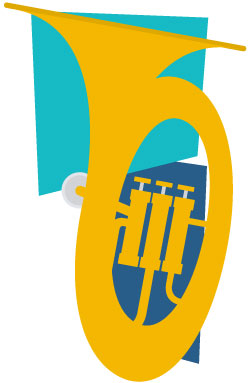Hey, Kids, It's a Tuba | History, Fun Facts, and More
from the Meet the Orchestra Index
Hey, Kids, It's a Tuba
Learn tuba history, how it's made, how it's played, about the tuba family, and a fun fact.
The Tuba is the largest and lowest sounding member of the brass family. Its sound is very round and mellow. The tuba, along with the string basses and bassoons, provide the lowest sounds for the orchestra.
History
The tuba is the youngest of all the brass instruments. It was invented in the middle of the nineteenth century, replacing the ophicleide (ahf-i-clyde). In the 1800s it joined the military band. About 100 years later the tuba was included as a regular member of the symphony orchestra.How It's Played
The symphonic tuba player holds the instrument in his lap, with the bell pointing up. To make a sound the player buzzes his/her lips into a large cup-shaped mouthpiece. To change notes the player selects and presses down on different valve combinations.How It's Made
Some tubas have piston valves (the button thingies) like the trumpet. Other tubas have rotary valves (the lever thingies)like the french horn. The brass tubing for the tuba begins at the mouthpiece, and bends and folds until it finally flairs, forming a large bell. If you were to stretch the metal tubing out it would be eighteen feet long.
The Tuba Family
The three most popular tubas include the C tuba, Bb tuba and the Sousaphone.1) The C tuba is the most commonly used tuba in the United States symphony orchestras because of its ability to play in tune with the other instruments of the orchestra.2) The Bb tuba is the most common instrument of tuba among players in German, Austrian and Russian orchestras. It is also the most common instrument for student tuba players.
3) The Sousaphone, invented by John Phillip Sousa, is the modern version of the helicon. Both instruments are designed to make the instrument easy to carry, and to project the sound toward the audience.
Fun Fact
Tubas are made of brass, a metal made of copper and zinc. Both of these metals are found in vitamins. This means that during your life you may eat an entire tuba - and it would be good for you!Watch a Video
Watch a How It's Made - Tuba video that will offer your kids a virtual field trip to a musical instrument factory.Browse Related Free and Premium Sheet Music and More
Worksheets
Meet the Orchestra Scavenger Hunt | Brass Family Worksheet